Art World
‘You Start the Game Tired’: What It’s Like to Be One of the Few Black Students at an Elite Art School
At a time when work by some black artists is more in demand than ever, life at the academy remains riddled with obstacles.
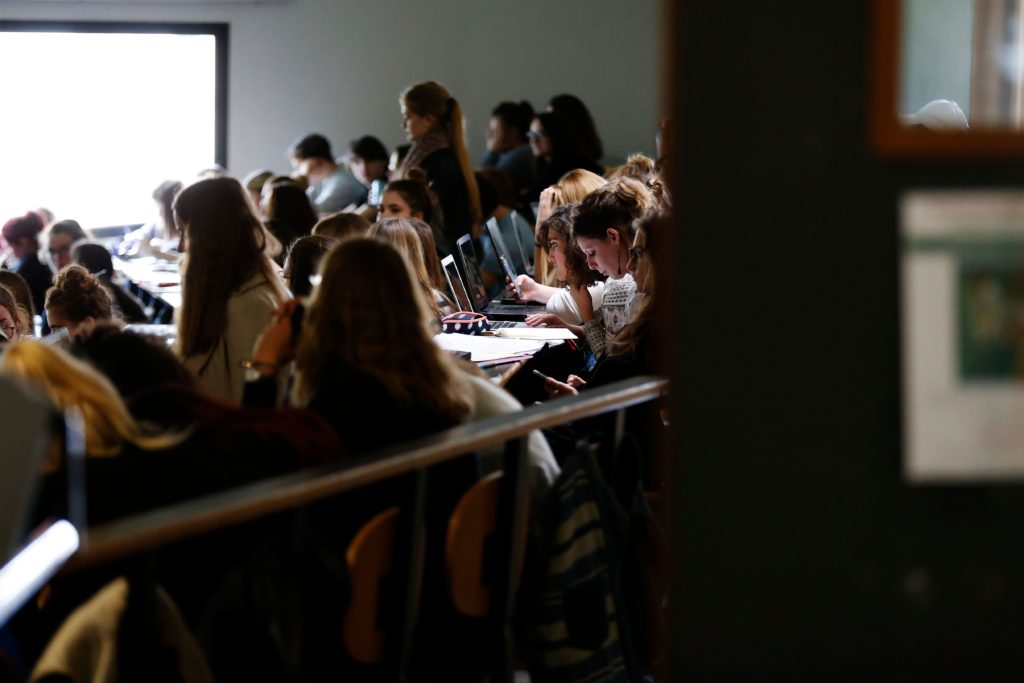
At a time when work by some black artists is more in demand than ever, life at the academy remains riddled with obstacles.

Melissa Smith

Kandis Williams decided to go to art school because she loved painting. Her subjects were mainly the people she grew up around in Baltimore. When Williams was accepted into Cooper Union, the prestigious art school in New York City, in 2003, she was excited to spend time refining her craft around other artists. But the environment was not as welcoming as she had hoped it would be.
She found that her professors and fellow students would routinely dismiss her opinions, especially if she were pointing out blind spots in the curriculum. “For black artists, there was a combative nature to just being present,” says Williams, whose work reflects on black aesthetic movements and who now shows with Night Gallery in Los Angeles. “There was no kind of race dialogue. If I brought up what black artists have contributed, they would call me a historical revisionist.”
While a handful of black artists have received unprecedented institutional acclaim and art-market attention in the years since Williams graduated, the percentage of black students attending top art schools still generally maxes out in the single digits—although, in some cases, as at Cooper Union, the high single digits.
According to IPEDS, a data portal for surveys conducted by the National Center for Education Services, around three percent of the incoming undergraduate students from 2010 to 2017 at the School of the Art Institute of Chicago were black, while American-born white students comprised one-third of the student body in 2017. (If one includes international students, the proportion of non-black students is much higher, per College Factual.)
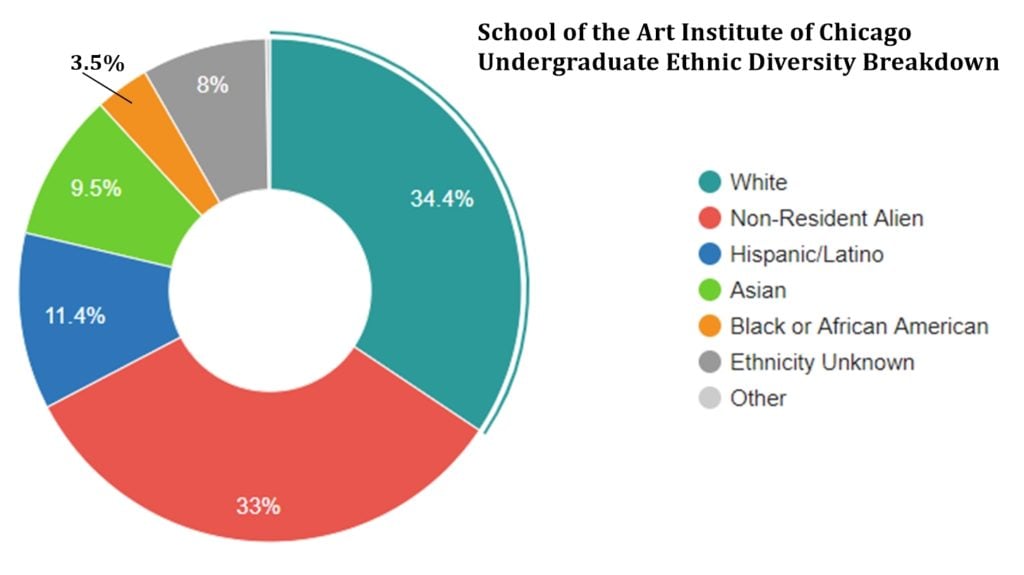
Data courtesy of College Factual.
Accounts of life at art school paint a complicated picture of what it takes for black artists to ascend the art-world ranks. This article is a companion to an earlier piece that explored burnout for established black artists in today’s frenzied art world and market. In reality, however, the stresses begin much earlier. Nearly all of the artists I spoke to shared their encounters with racism in the strikingly white-dominated academy. These experiences also help pinpoint the root of burnout for so many black artists who, from the start, are confronted by a system not designed to accommodate them.
Art school is all-consuming. Because black students are sometimes more removed socially, politically, and economically from the elite art world than most of their white peers, their hold on that system still tends to feel precarious. “The lack of a safety net,” one artist says, “characterizes the lives of many black artists.”
Williams, for one, admits that being an artist is “foolish economically.” A graduate degree from the Art Institute of Chicago, RISD, or CalArts can run more than $50,000 per year. And apart from tuition, “you have a studio, you need to buy random stuff [to make it]. It’s a very crazy thing to do.” But often, many black artists note, they also have to balance these pursuits with grim personal realities, like being not too far removed from poverty or having family members who are incarcerated—systemic societal failures directly tied to race. One artist described it as always feeling like her attention was divided, looking forward and backward all at once.
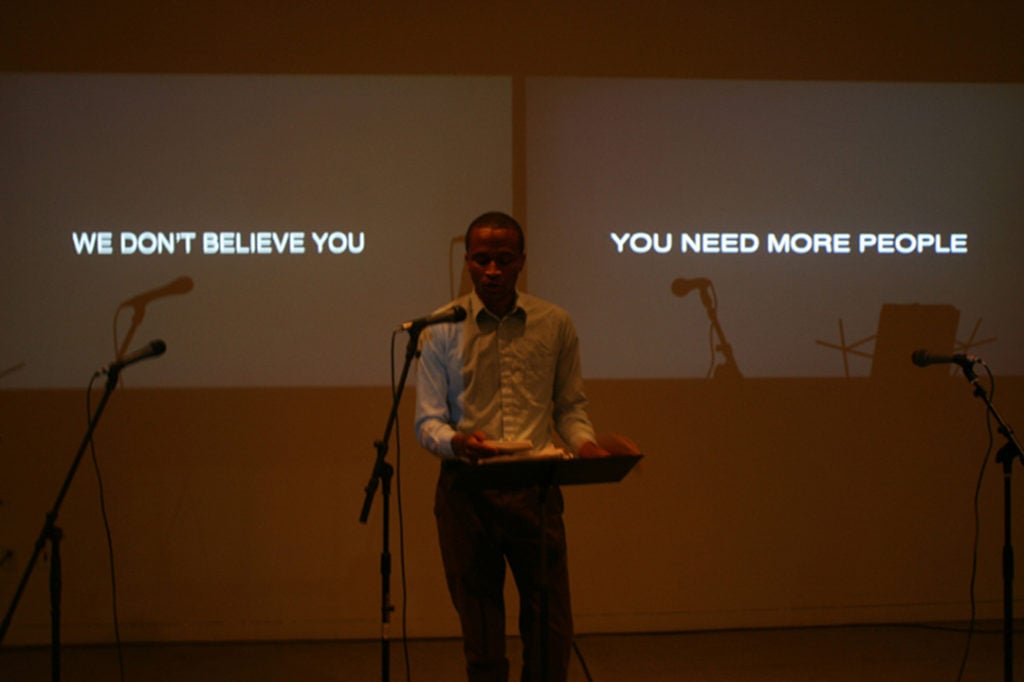
Jibade-Khalil Huffman, We Don’t Believe You, You Need More People (2011-2012), performance. Courtesy of the artist.
Jibade-Khalil Huffman, who graduated from Bard in 2003, has an MFA from both Brown and the University of Southern California, and is best known for his videos and photos exploring the boundaries of text and image, notes that black art students typically have to convince professors of the importance of their work, while anything produced by their white peers is blindly accepted as culturally neutral—a phenomenon that plays out in any number of racially lopsided environments.
“They’re letting in the same people that reflect their experience,” he says. “And before anything can even happen, I have to prove that this thing that I’m making—which is outside of what they understand—[is valid]. I have to explain and justify my existence as a black person. So you start the game tired.”
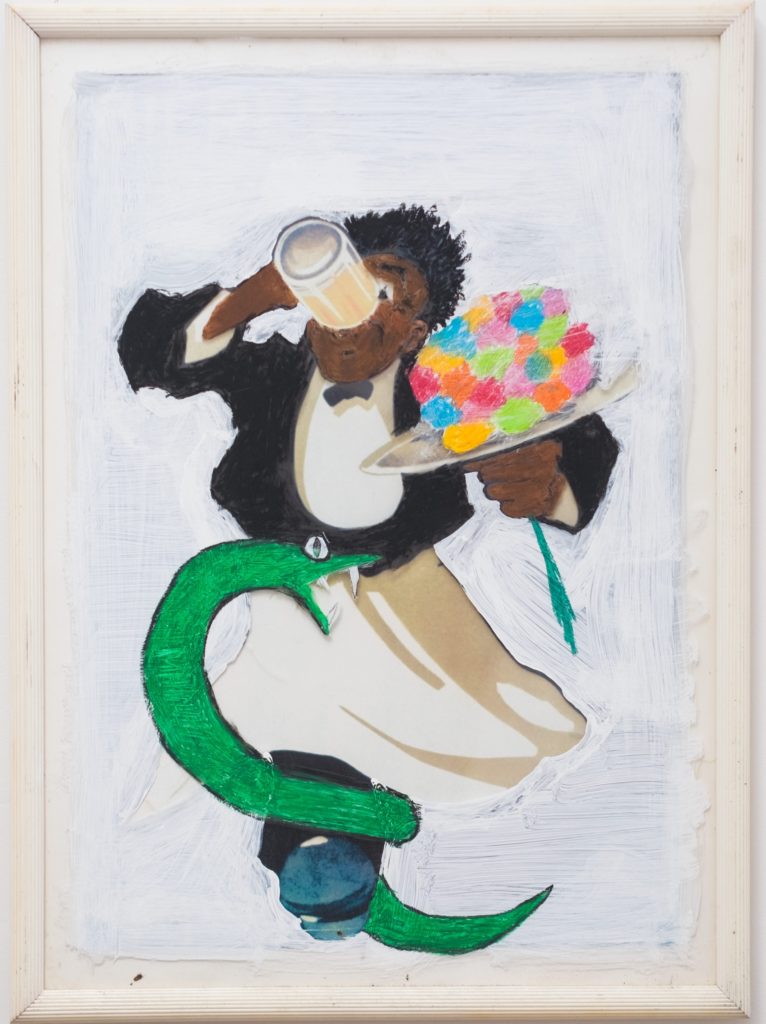
Parker Bright, Servitude (2017). © Parker Bright.
This paradigm has not changed dramatically since Williams and Huffman were in school. At the School of the Art Institute of Chicago, recent grad Parker Bright (the young artist made famous for his protest of Dana Schutz’s painting of Emmett Till for the 2017 Whitney Biennial) also felt a disconnect. “Certain aesthetic choices that were so wrapped up in the black world, people couldn’t understand them,” he says. “And I totally felt the opposite. I was like, I feel like my work is very relatable. It’s really just talking about how I exist.”
An art school’s reputation hinges on the professional success of its students. In grooming them to compete for the right kind of art-world recognition—from reputable galleries and other institutions that can offer career-enhancing shows—some artists say their professors promoted and privileged the work of white male artists over all others, leading them to reconsider the direction of their practice, or question their fundamental worth as artists.
Williams recalls a teacher who once told her that she should quit painting black people because her work too closely resembled folk art. In the mid-aughts, when she was attending Cooper, not many acknowledged how impactful representing black figures with a sense of agency could be for future generations of black artists. Kehinde Wiley’s triumphant images were fine. But work reminiscent of Henry Taylor’s—an artist now celebrated for depicting normal, everyday black lives—wasn’t as acceptable back then, she recalls.
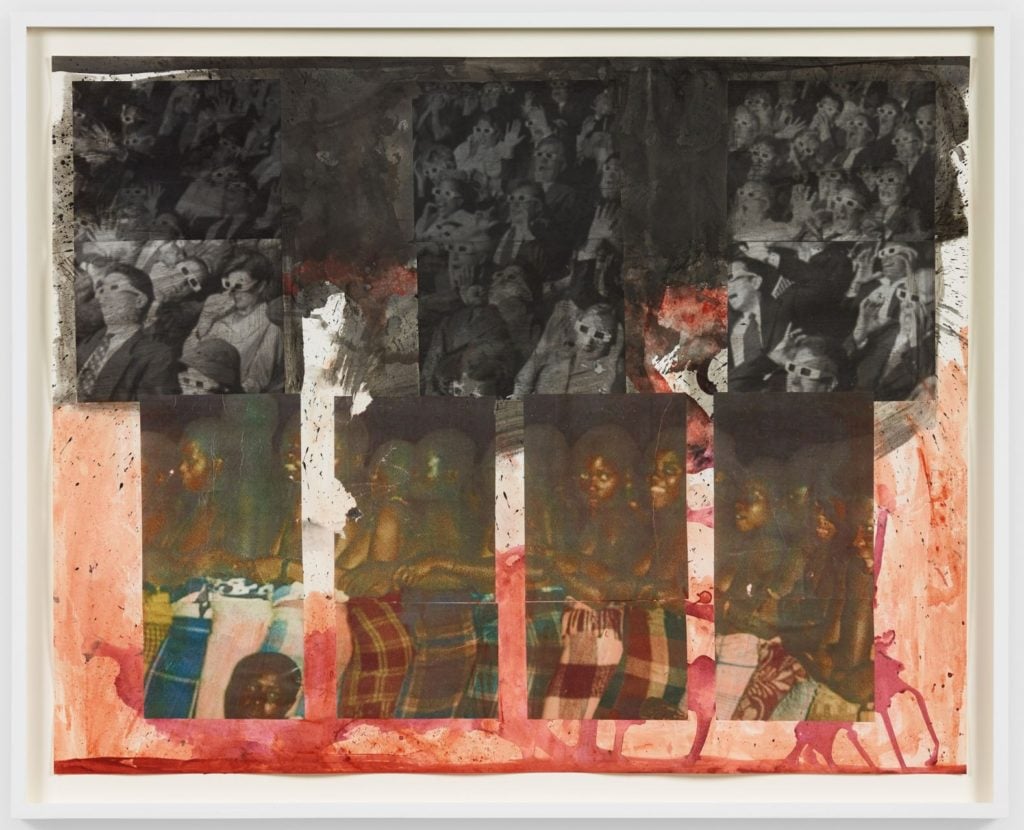
Kandis Williams, “And the self and not-self are either the same or the opposite” (2019). Courtesy of the artist and Night Gallery.
“He really failed me as a teacher because he just stopped teaching me painting,” Williams notes of her professor, “and from then on, he refused to talk to me about anything but assemblage or whatever black stuff he had read in a newspaper.”
Williams eventually moved into a more conceptual space, but notes that neither that professor nor any other introduced her to the work of influential black artists and thinkers like Adrian Piper and Audre Lorde. (It is worth noting that since Williams attended Cooper Union, the school has made an effort to hire more black faculty, including Leslie Hewitt and William Villalongo, among others.) Years later, however, when Williams confronted her professor about the part he played in altering her practice, he wouldn’t admit that his advice was at all influenced by race. “His response was to lean over to one of his white colleagues—and my former classmate—and say, ‘black students are always so difficult,’” she recalls.
A number of today’s most acclaimed black artists—including Jordan Casteel, Mickalene Thomas, and Kehinde Wiley—graduated from Yale, a critical pipeline for all aspiring artists, but especially for art students of color. Recently, Yale has also proactively recruited black faculty members (many of whom either didn’t respond or declined to be interviewed for this piece), though there remains room for improvement.
The move could potentially be transformative. In an i-D article featuring interviews with recent Yale grads, artist Felipe Baeza noted that people of color still “had to explain that every decision in their work had a meaning, when a white person who was painting was not asked the same questions.”
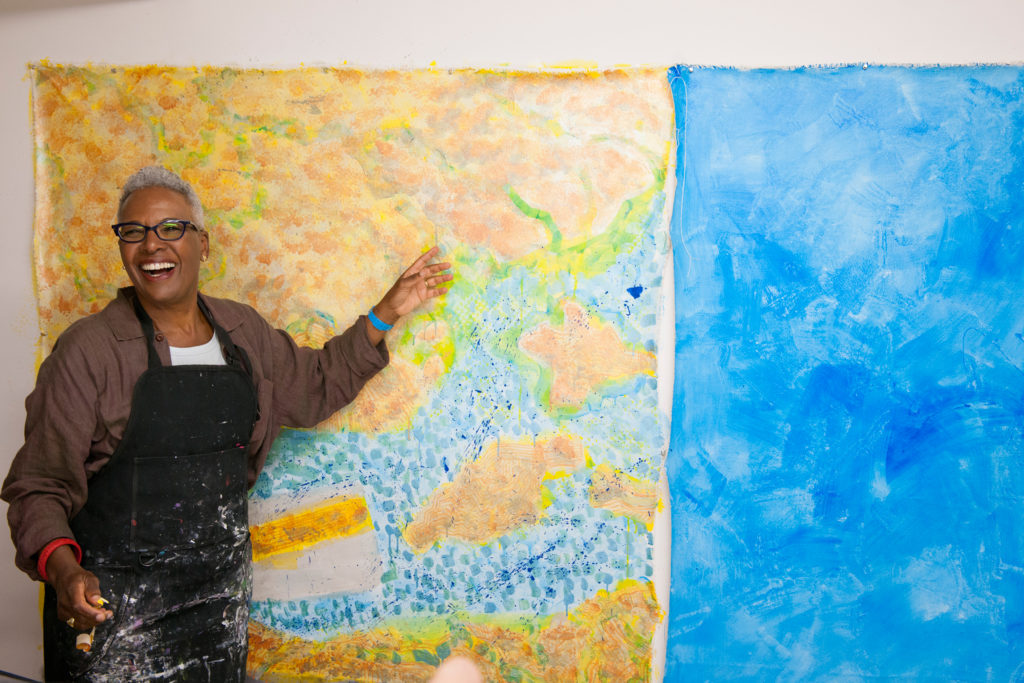
Nell Painter, author of Old in Art School. Photo: John Emerson.
Establishing a diverse student body and faculty could have prevented some of the challenges that Nell Painter—the celebrated black historian turned artist—experienced and detailed in her memoir about art school, which she began attending at age 64. Painter pursued her undergraduate art degree at Rutgers University’s Mason Gross School of Art, and her BFA at RISD.
At both institutions, she describes feeling ostracized and her work misinterpreted by other students (and professors) on account of her race. She credits having graduated at all in large part to a network she built outside of school, not in it. “I’d been around long enough to make a lot of friends,” Painter says. “And then there comes a time when some of those people will save your life—save my life. And they did.”
For black artists, the psychological toll of constantly trying to prove their worth in school is a frequent source of burnout—and reemerges time and again as they make their way within the art world, feeling more and more emotionally depleted as they go.
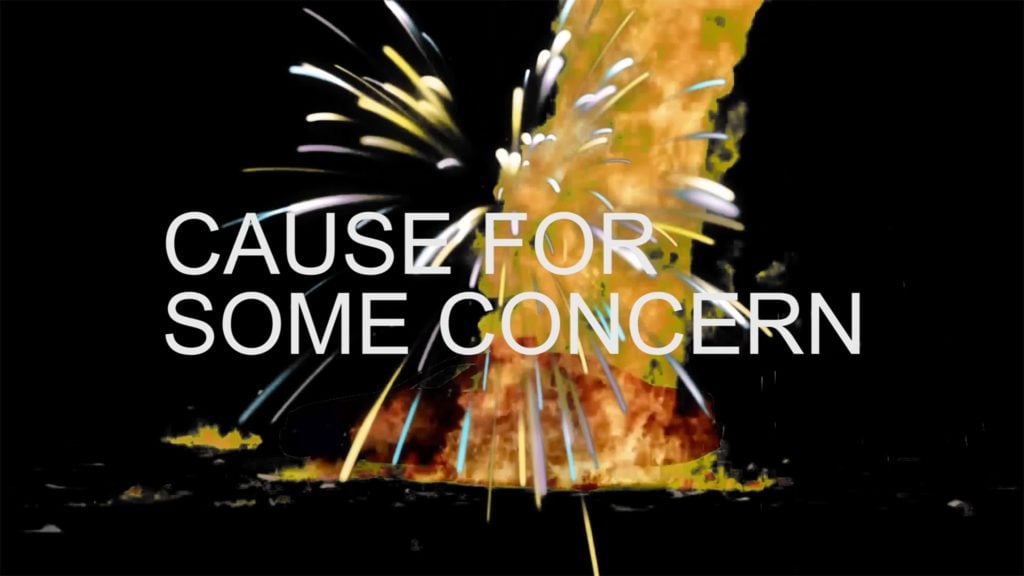
Jibade-Khalil Huffman, First Person Shooter (2016). Courtesy of the artist and Anat Ebgi. Photo: Art Basel.
It’s no coincidence that when I’d first reached out to black artists, dealers, and curators for this story, most of them mentioned regularly venting about burnout to other black friends and colleagues. Within the larger art world, however, they’re more inclined to downplay their experiences. Speaking up about burnout can cause even more burnout: rehashing your race-related stressors while simultaneously worrying about how that information will be received and telegraphed isn’t especially therapeutic.
And with that, the cycle of black burnout continues.